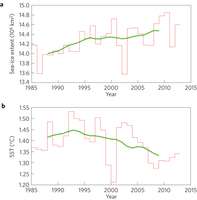Austral winter half-year (April–September) trends in sea-ice extent (total Southern Hemisphere) and SST (averaged over 50°–90° S). Credit: Nature Geoscience (2013) doi:10.1038/ngeo1767
(Phys.org) —A team of researchers from the Netherlands, led by Richard Bintanja, has published a paper in the journal Nature Geoscience, contending that the reason the amount of annual Antarctic sea ice is increasing is because of increased ice sheet melting during the summer months. They suggest that the increased melt creates a cold layer of fresh water on the ocean surface that is easily frozen when the next winter arrives.
Over the past several years, scientists have found something that appears to go against common sense—as the planet undergoes global warming, sea ice expansion around Antarctica has been growing each year instead of contracting as has been the case with sea ice around the Arctic. The reason for this has not been clear and researchers have been offering a variety of possible explanations—last year ocean modelers at the British Antarctic Survey in Cambridge, published a paper suggesting that changes in wind patterns in the area were responsible.
In this new effort, the group from the Netherlands suggests it's more likely due to increased heat in the summer leading to an increase in offshore ocean temperatures. That warmer water, they theorize, causes melting of the ice sheets from below. Then, because the water from the ice that melts has little salt in it, it tends to float, creating a layer of cold water sitting on top of the warmer saltier water below, which easily freezes when cold winter temperatures return. The researchers suggest that the cold layer of water created offshore may also be responsible for lower than average snowfall in Antarctica, as it cools the air above it—cooler air holds less moisture.
The researchers came to these conclusions by using existing models that simulate conditions in Antarctica to build new models based on what would likely happen in the sea should the ocean experience warming. Their model, they claim, indicates that increased ice expansion around the continent is most likely due to summer melt, though they acknowledge that some might also be due to changes in wind patterns due to global warming as well. They note also that despite the increase in surface ice expansion each winter, the total mass of ice around Antarctica is continuing to shrink (by about 250 billion metric tons a year) because of the underside melting of the sheet ice.
More information: Important role for ocean warming and increased ice-shelf melt in Antarctic sea-ice expansion, Nature Geoscience (2013) doi:10.1038/ngeo1767
Abstract
Changes in sea ice significantly modulate climate change because of its high reflective and strong insulating nature. In contrast to Arctic sea ice, sea ice surrounding Antarctica has expanded, with record extent in 2010. This ice expansion has previously been attributed to dynamical atmospheric changes that induce atmospheric cooling3. Here we show that accelerated basal melting of Antarctic ice shelves is likely to have contributed significantly to sea-ice expansion. Specifically, we present observations indicating that melt water from Antarctica's ice shelves accumulates in a cool and fresh surface layer that shields the surface ocean from the warmer deeper waters that are melting the ice shelves. Simulating these processes in a coupled climate model we find that cool and fresh surface water from ice-shelf melt indeed leads to expanding sea ice in austral autumn and winter. This powerful negative feedback counteracts Southern Hemispheric atmospheric warming. Although changes in atmospheric dynamics most likely govern regional sea-ice trends4, our analyses indicate that the overall sea-ice trend is dominated by increased ice-shelf melt. We suggest that cool sea surface temperatures around Antarctica could offset projected snowfall increases in Antarctica, with implications for estimates of future sea-level rise.
Journal information: Nature Geoscience
© 2013 Phys.org




















